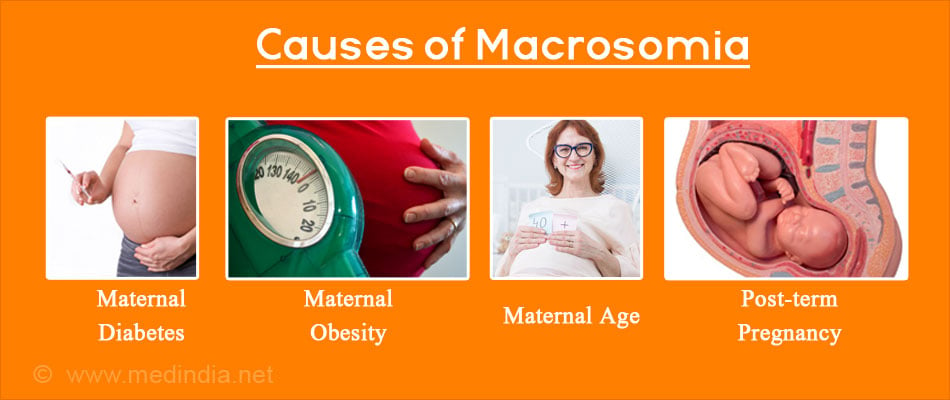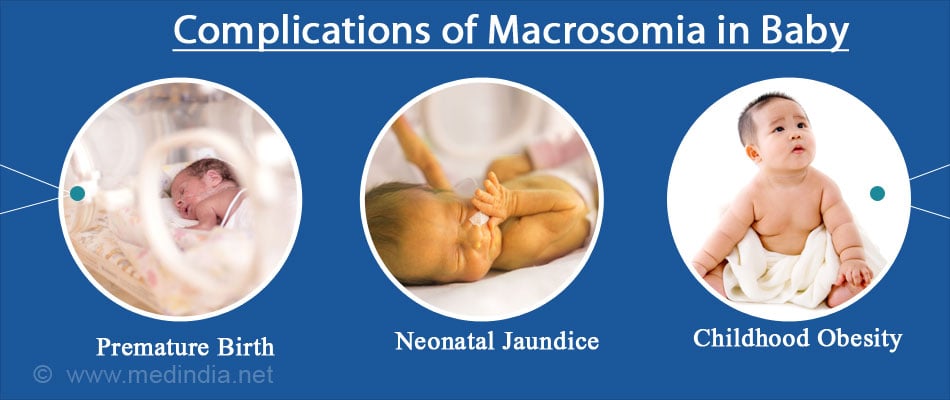- Fetal macrosomia - (http://www.mayoclinic.org/diseases-conditions/fetal-macrosomia/basics/definition/con-20035423?p=1)
- Management of Suspected Fetal Macrosomia - (http://www.aafp.org/afp/2001/0115/p302.html)
- What is Fetal Macrosomia? - (http://www.birthinjuryguide.org/birth-injury/causes/fetal-macrosomia/)
- Gestational diabetes mellitus and macrosomia: a literature review. - (https://www.ncbi.nlm.nih.gov/pubmed/26045324)
What is Macrosomia?
Macrosomia or fetal macrosomia is a condition where a newborn child weighs more than 4000 grams irrespective of the gestational age.
Macrosomia is present in about 9% of babies in the world. Macrosomia is a high risk for pregnancy. Macrosomia complicates the delivery. It can cause injuries to the baby and vaginal canal during delivery. A cesarean section (C-section) is considered in pregnancy with fetal macrosomia but sometimes the fetal weight estimation with ultrasound can be on the higher side which can lead to unnecessary C-sections.
What are the Causes of Macrosomia?
Macrosomia can be due to fetal or maternal causes. Fetal causes include genetic causes and other fetal disease conditions which can accelerate fetal growth. Maternal diabetes or obesity are also associated with fetal macrosomia.
The following are a few factors which increase the risk of fetal macrosomia.
- Maternal diabetes: Either pre-gestational or gestational diabetes in the mother increases the risk of fetal macrosomia.
- Maternal obesity: Obesity in the mother increases the chance of fetal macrosomia.
- Maternal age: of more than 35 years increases the risk of fetal macrosomia.
- Excess maternal weight gain: Excess weight gain during pregnancy increases the risk of fetal macrosomia.
- Previous macrosomia babies: Mothers who have had babies born with macrosomia previously have higher chances of having macrosomia babies in the following pregnancies.
- Multiparity: As the number of pregnancies of the mother increase, fetal weight also increases and hence the chance of having macrosomia babies.
- Male child: Newborn male babies are slightly heavier than female babies.
- Parental stature: Large parental stature increases the risk of macrosomia.
- Need for labor induction and prolonged second stage of labor also increase the risk of macrosomia.
- Post-term pregnancy: If the pregnancy is 2 weeks post term the chances of having a macrosomia baby are high.

What are the Symptoms and Signs of Macrosomia?
There are no specific signs and symptoms for macrosomia but the following are a few possible signs.
- Large fundal height: Fundal height is the measure between the pubic bone and the fundus of the uterus. The obstetrician measures this length in the mother during visits. In a pregnancy with fetal macrosomia, the fundal height is more than expected.
- Polyhydramnios: It is a condition during pregnancy where the amniotic fluid (the protective fluid which is present around the fetus) is more than the normal amount. Polyhydramnios is seen in fetal macrosomia because the fetal is large it produces more urine, which contributes to the amniotic fluid.
What are the Complications of Macrosomia?
Complications in the mother:
- Vaginal delivery may get complicated warranting the need for a vacuum or forceps assisted delivery.
- Increased chances of unplanned or emergency cesarean section.
- Increased chance of vaginal tears or perineal tears.
- Heavy bleeding and postpartum hemorrhage: Uterine atony can lead to increased bleeding and post-partum hemorrhage.
- Uterine tear: If there is a previous history of cesarean section there are chances for a uterine tear in the case with fetal macrosomia.
Complications in the baby:
- Premature birth: Premature rupture of the membranes due to macrosomia leads to premature birth. Premature birth is associated with complications like jaundice, respiratory and feeding difficulties.
- Shoulder dystocia: Because of the macrosomia, it may be difficult to deliver the shoulder and it can cause injuries to the baby. It can cause brachial plexus injury.
- Hypoglycemia: Macrosomia babies born to mothers with maternal diabetes can be hypoglycemic after birth.
- Neonatal jaundice: Jaundice in macrosomia babies is due to premature birth and polycythemia (increase in red blood cells).
- Congenital anomalies: Macrosomia babies born to mothers with gestational diabetes can have congenital anomalies due to high blood sugar levels.
- Childhood obesity: It is common in macrosomia babies born to the mother with maternal diabetes.
- Metabolic syndrome: It is also common in macrosomia babies.

How do you Diagnose Macrosomia?
The diagnosis of fetal macrosomia before the delivery is difficult and inaccurate. The definitive diagnosis can only be made after the child’s birth and weighing the baby. But if a pregnant female has risk factors, then the following investigation is useful.
Ultra-Sonogram (USG): USG helps to measure the fetal weight though the accuracy of the test is unreliable.
How do you Treat Macrosomia?
If the doctor suspects fetal macrosomia, he might suggest a
- Cesarean Section if the:
- Pregnant female has maternal diabetes due to pre-gestation diabetes or gestational diabetes
- Fetal weight is more than 5000 grams
- Previous delivery had a complication of shoulder dystocia (a condition where the shoulder of the baby is stuck under the pelvic and which can lead to a fracture of the collar bone)
- Vaginal delivery is also an option in patients with suspicion of fetal macrosomia but the delivery should be conducted in the hospital because it may be necessary to use forceps or vacuum to deliver the baby or sometimes cesarean section may become necessary.
- In women with maternal diabetes a good control of blood sugar levels is necessary.
How do you Prevent Macrosomia?
Preventing macrosomia is not possible although maintaining good health during pregnancy is possible.
- Weight: It is essential to maintain appropriate weight before pregnancy and during pregnancy since obesity is associated with macrosomia.
- Diabetes: Blood glucose levels before and during pregnancy should be maintained well.
- Physical activity: Physical activity during pregnancy should be as per the recommendations of the doctor.









